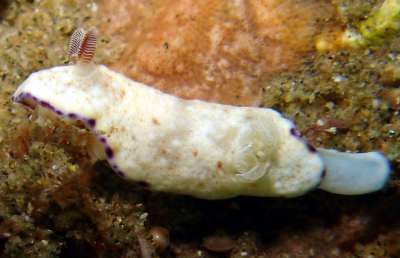Unidentified Chromodoris feeding & damaged
October 15, 2005
From: Colin Ogden

Hi Bill,
Tthis morning I came across these 2 nudis, which I have seen often, but I can't ID them. In these photos the first one is feeding on a sponge, but the second one, about 10 metres away has one of its rhinopores missing. We occasionally see nudis with extensive physical damage but they seem to survive regardless, so they must be fairly tough little things. This is the first one I have seen with a rhinopore missing.
Locality: Sodwana Bay, South Africa, Indian Ocean. Depth: 10 metres. Length: 5 cm. 12 October 2005. Sponge algae reef. Photographer: Colin Ogden
Thanks for all the help you have given me. I really do appreciate it. As part of Marine week next week we will be putting together a slide show of all the sea slugs we find at Sodwana Bay and so far it appears that we have photos of close to 150 different species. Is this a large number for one area or is it about what we should expect?
regards
Colin
scubaco@iafrica.com



Dear Colin,
This is a species I named Chromodoris alius, but as you will see on the Fact Sheet I have some doubts about just how many species there are in this colour group. I sometimes have doubts about other people's new species, so at least this shows I am not biased. One of your animals certainly looks as though something has removed a rhinophore, but as you say they seem to survive quite a lot of damage.
I'm afraid the first one is not feeding. In the close-up it certainly looks like it is taking a big bite, but the pair of 'fangs' at the top are in fact its oral tentacles. If it were feeding the buccal bulb would be emerging from between those tentacles. However I much prefer to get photos that turn out not to show feeding, than for you to hesitate and not send me a feeding record because you weren't sure.
150 species is a good haul for the time you have been looking. Terry Gosliner recorded about 270 species in his book, but that include the southern cape fauna as well as the more tropical element on the Indian Ocean coast. I would guess that you will gradually double that number as tropical visitors arrive as larvae from further north. If you start targeting special habitats, such as hydroids, and particular algae, or small things etc etc you will start to find another new group to increase your numbers. You are in fact sampling the Indian Ocean - it won't all be there at once, but over a number of years, if you retain your interest you will be reguallry rewarded with new records.
Best wishes,
Bill Rudman
Related messages
-
Re: Juvenile Chromodoris alius from Reunion Island
From: Hugues Flodrops, February 14, 2008 -
Chromodoris rufomaculata? from Sri Lanka
From: Marina Poddubetskaia, February 19, 2005 -
Chromodorid from Sodwana, Sth Africa
From: Charles Rowe, February 5, 2004 -
Chromodoris alius from South Africa
From: Valda Fraser, November 21, 2001 -
Chromodoris alius? from South Africa
From: Valda Fraser, September 18, 2000 -
What is Chromodoris alius?
From: Atsushi Ono, June 23, 2000
